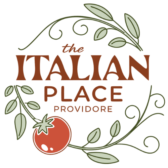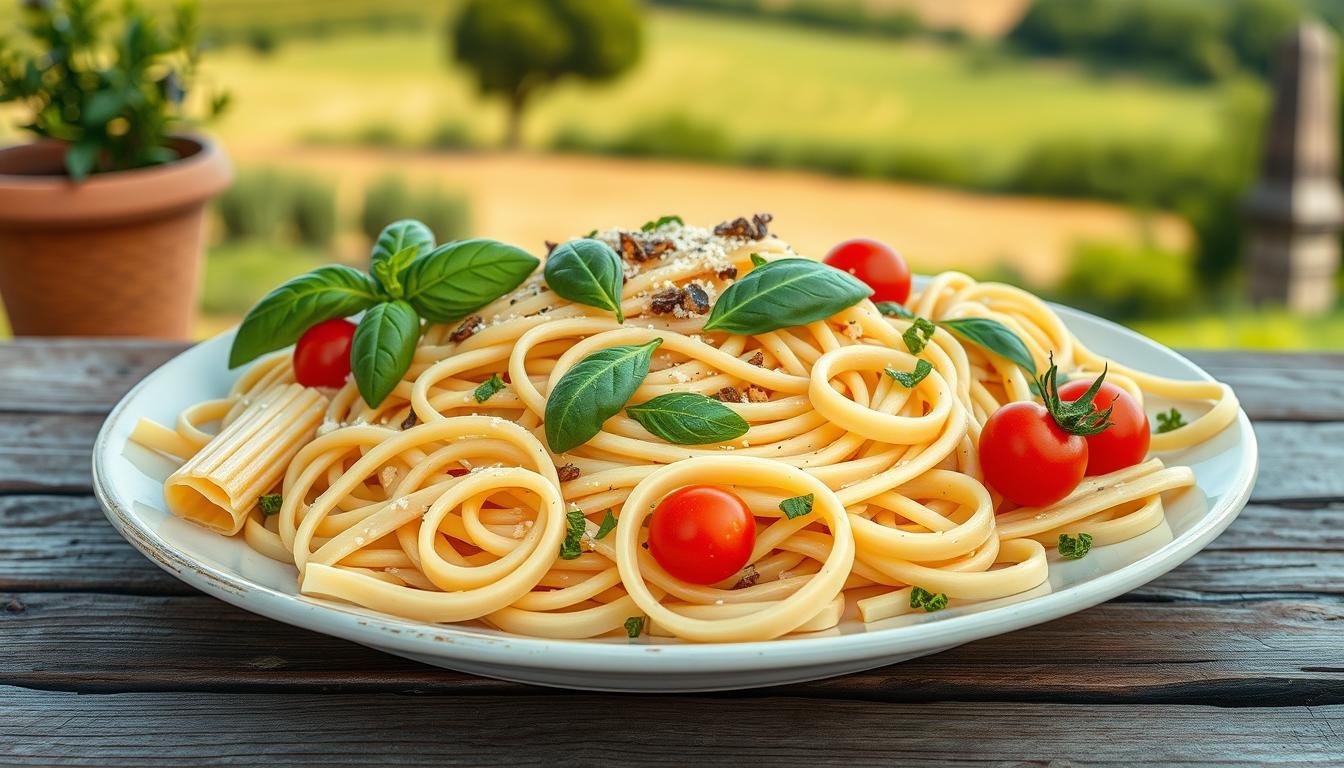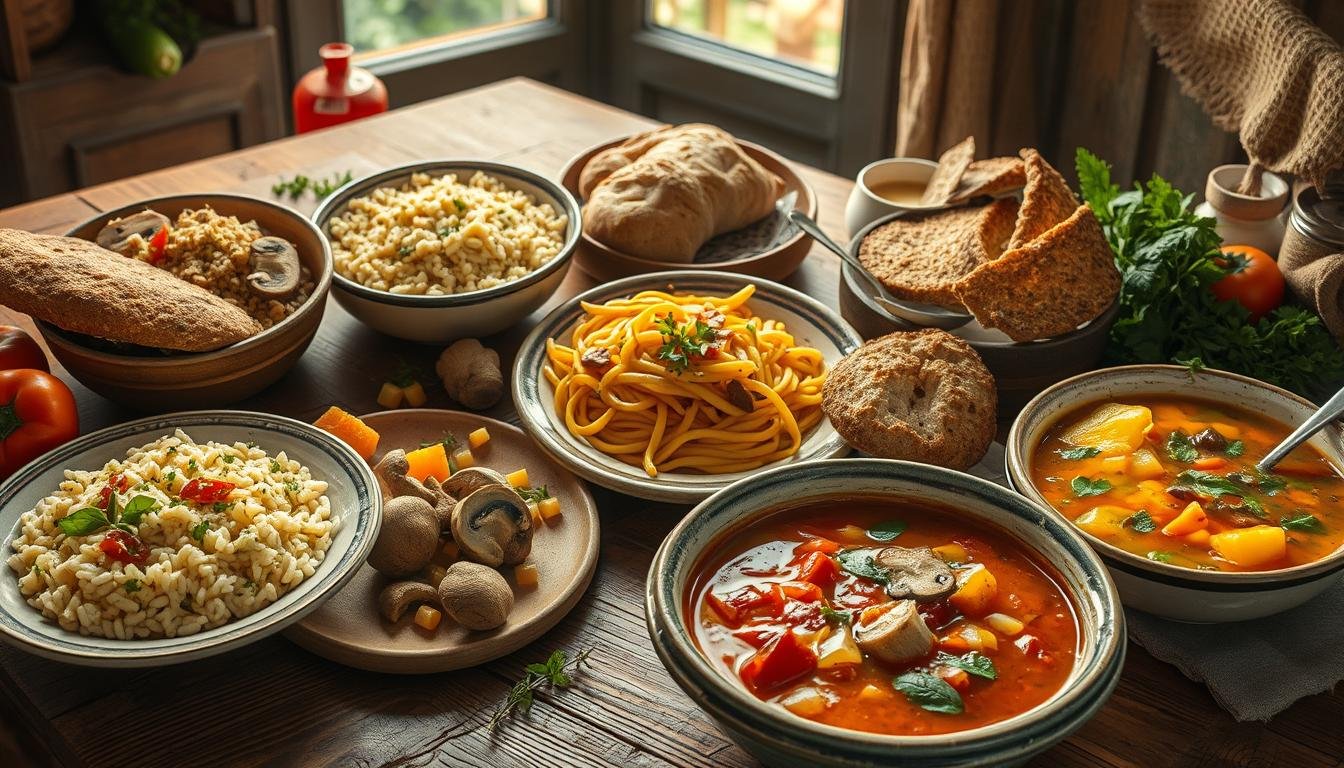Explore the world of traditional Central Italian pasta dishes. Each bite takes you to Rome’s cozy trattorias. Try cacio e pepe and amatriciana for a taste of Italy in your kitchen.
Key Takeaways
- Discover the authentic flavours of classic Central Italian pasta dishes
- Explore the diverse regional cuisine of Central Italy through its iconic pasta creations
- Learn how to recreate the comforting and nostalgic experience of dining in a Roman trattoria
- Uncover the unique ingredients and cooking techniques that define Central Italian pasta
- Gain inspiration to elevate your pasta-making skills and bring a touch of Italy to your home
Introduction to Central Italian Pasta
Central Italian pasta dishes come from a rich culinary history. This area is known for its unique, high-quality ingredients. These ingredients add authenticity and flavour to traditional Central Italian pasta ideas and fresh pasta recipes.
Overview of Central Italy’s Culinary Heritage
The regions of Lazio, Umbria, and Tuscany are famous for their food. They have exceptional produce and old cooking methods. From Parmesan cheese in Emilia-Romagna to Tuscan herbs and olive oils, their flavours are unique.
Unique Ingredients Used in Pasta Dishes
- Creamy Parmesan cheese, providing a rich, nutty taste
- Fragrant, high-quality butter and olive oil
- Fresh herbs, like rosemary, basil, and oregano, adding vibrant aromas
- Tomatoes, both fresh and sun-dried, for their bold, tangy flavours
- Cured meats, such as prosciutto and salami, lending a savoury depth
These top ingredients are used in simple yet beautiful pasta dishes. For example, fettuccine Alfredo shows off the quality of its ingredients.
“Central Italian pasta dishes are a celebration of the region’s exceptional produce and time-honoured cooking traditions.”
The cooking techniques in Central Italy also play a big role. Dishes like pasta cacio e pepe from Lazio show how pasta is cooked with sauce in a skillet.
Classic Pasta Shapes of Central Italy
Central Italy is known for its rich pasta shapes. Each shape has its own special character and history. From the elegant fettuccine to the rustic pici and the unique strascinati, these shapes show the region’s love for pasta-making.
Fettuccine
Fettuccine comes from the Lazio region. It’s a long, flat pasta that’s perfect for creamy sauces. Its texture and width make it a favorite for dishes like Fettuccine Alfredo.
Pici
Pici is from Tuscany’s hills. It’s a thick, hand-rolled pasta with a rustic feel. Unlike fettuccine, pici has a heartier bite. It’s great with meat-based sauces or simple dressings.
Strascinati
Strascinati is from the Marche region. It has a unique dragged look. This is because it’s made by hand-rolling and dragging the dough. It’s versatile and works well with tomato and creamy sauces.
These pasta shapes celebrate Central Italy’s pasta-making traditions. Each shape has its own charm and uses. Whether you like fettuccine, pici, or strascinati, Central Italy’s pasta shows its rich food culture.
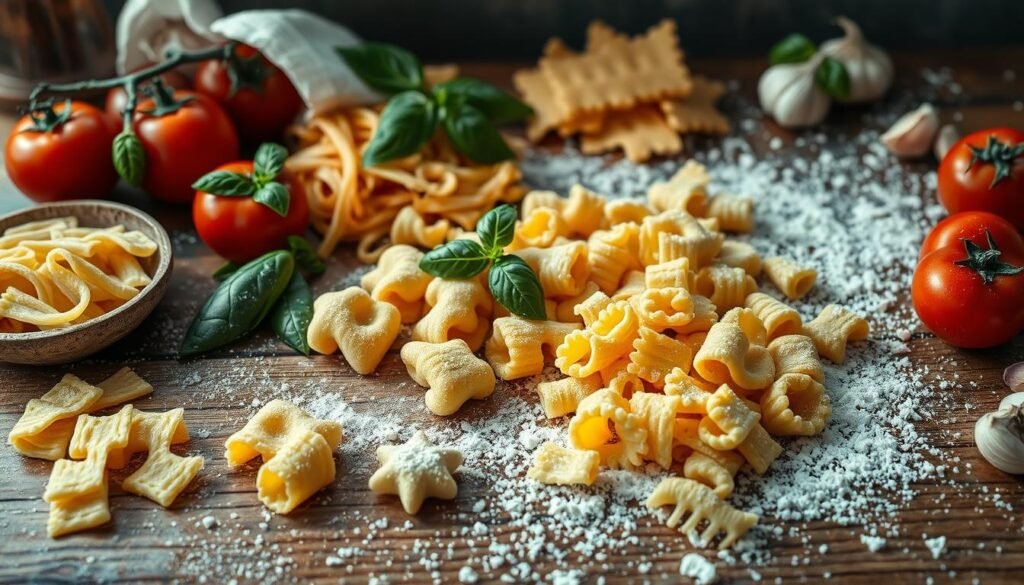
Sauces that Define Central Italian Pasta
Central Italian pasta dishes are famous for their rich and varied sauces. Each sauce has its own special taste and comes from a different area. From the well-known Ragu Bolognese to the spicy Arrabbiata, these sauces are key to real Italian food.
Variations of Ragu
The Ragu Bolognese is a slow-cooked sauce made with ground beef and pork. It’s a main dish from the Emilia-Romagna region. This sauce is often served with wide pasta like tagliatelle or pappardelle. Some places add milk or cream to make it creamy.
Tomato-Based Sauces
Tomato-based sauces are a big part of Central Italian cooking. The Arrabbiata sauce, from Rome, has a spicy touch from chili peppers. Amatriciana, from Amatrice, mixes guanciale, pecorino cheese, and tomatoes for a strong taste.
Creamy Sauces
Central Italy is also famous for creamy pasta sauces. The famous Cacio e Pepe is a simple yet rich dish. It uses Pecorino Romano cheese and black pepper for a perfect mix of flavours. Alfredo, with its Parmesan and butter, is another creamy favourite that goes well with classic pasta.
“The beauty of Central Italian pasta sauces lies in their ability to showcase the region’s finest ingredients, from locally sourced meats to sun-ripened tomatoes and fragrant herbs.”
Popular Dishes in Central Italy
In Central Italy, some pasta dishes are true culinary classics. Cacio e Pepe, Pasta alla Gricia, and Pici Cacio e Pepe are standout dishes. They show the simplicity and flavour that make the region’s food special.
Cacio e Pepe
Cacio e Pepe is a beloved Roman dish loved worldwide. It’s made with Pecorino Romano cheese, black pepper, and pasta water. The result is a creamy, peppery sauce that coats the pasta perfectly.
Pasta alla Gricia
Pasta alla Gricia is another Roman favourite. It uses guanciale (cured pork cheek) and Pecorino Romano cheese. The salty guanciale and sharp Pecorino make a flavourful sauce, with black pepper adding a subtle heat.
Pici Cacio e Pepe
Pici Cacio e Pepe comes from Tuscany. It uses thick, hand-rolled pici pasta instead of traditional spaghetti. The ingredients are the same, but the pici pasta adds a unique texture.

These dishes show the beauty of Central Italian cuisine. They highlight the quality of ingredients and the skill of cooking. They are beloved classics that delight pasta lovers everywhere.
Seasonal Ingredients in Central Italy
Central Italy’s rich food culture is all about using fresh, seasonal ingredients. These ingredients change with the seasons, bringing new flavors to classic pasta dishes. This shows the region’s love for regional Italian cuisine and fresh pasta recipes.
Spring Produce Brightens Pasta
Spring brings fresh herbs and veggies to Central Italian pasta. Artichokes are a favorite, used in sauces or as fillings. Spring greens like wild fennel add a fresh touch.
Summer’s Abundant Bounty
Summer brings warm weather and vibrant flavors to pasta. Juicy tomatoes are the star, in sweet sauces. Zucchini is used in fillings or with garlic and olive oil for a tasty side.
Autumn’s Hearty Ingredients
Autumn brings earthy flavors to pasta. Pumpkin and mushrooms add depth to sauces and fillings. These veggies show the region’s love for local, seasonal produce.
Central Italy’s pasta dishes change with the seasons. This shows the region’s deep respect for nature’s bounty. Every bite celebrates the local food culture and the seasons.
Pasta-Making Techniques
In Central Italy, making pasta by hand is a cherished tradition. It uses old tools and careful shaping of each noodle. These methods show the region’s deep love for food.
Using Traditional Tools
The chitarra, a stringed pasta cutter, is key in Central Italy. It makes noodles with a unique texture. This tool is used for fettuccine and other pasta shapes.
Running the dough through the chitarra’s wires is rhythmic. It makes pasta that looks and tastes handmade. This pasta is perfect with the region’s strong sauces.
Handmade vs. Store-Bought
Handmade pasta is special, but store-bought is convenient. Central Italian dishes are better with handmade noodles. Making pasta by hand takes skill and patience.
The irregular shapes and thickness of handmade pasta are unique. They hold sauces better, making meals more enjoyable.
| Handmade Pasta | Store-Bought Pasta |
|---|---|
| Irregular shape and thickness | Uniform shape and thickness |
| Rustic, artisanal texture | Smooth, consistent texture |
| Able to better capture and hold sauces | May not hold sauces as well |
| Time-consuming, requires skill | Convenient, easy to prepare |
Making pasta by hand is crucial in Central Italy. It shows the region’s love for food. Whether made with old tools or by hand, these pastas are loved worldwide.
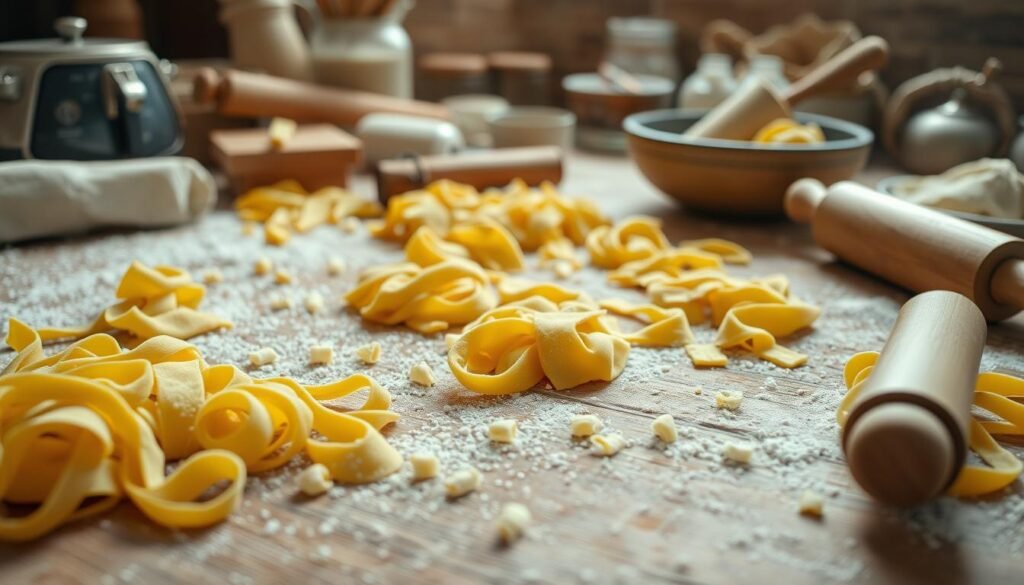
How to Pair Pasta with Wine
Central Italy’s culinary traditions are rich and diverse. Pairing the perfect wine with pasta is key to a great meal. Choose wines that bring out the best in both pasta and sauce, making the meal unforgettable.
Choosing the Right Wine
Light, acidic white wines go well with creamy pasta. Robust reds match tomato-based sauces. The wine’s alcohol level is also crucial, as pasta dishes rarely exceed 13% alcohol.
Local tastes and what’s available affect wine choices. But, Italians often prefer wines that don’t overwhelm their food. They avoid strong reds and oaky whites.
Regional Wine Suggestions
- For Pizzocheri from Lombardy, Valtellina, a light red from Nebbiolo, is a top choice.
- Chianti Rufina is perfect for meat-based pasta, thanks to its light, juicy taste.
- Barbera’s acidity is great for tomato-based dishes like Pasta alla Gricia.
- Nero d’Avola pairs well with Duck Ragu due to its fragrant and light to medium body.
- Fiano’s acidity is ideal for cream-based sauces, such as Cacio e Pepe.
- Sauvignon Blanc balances the salt in goat’s cheese dishes, like Pasta alla Norma.
- Vermentino’s salty complexity is perfect for rich cheese-based pastas, like Carbonara.
By choosing wines that enhance your pasta’s flavors and textures, you’ll make your meal special. This way, you can truly enjoy Central Italy’s culinary traditions.

Vegetarian Options in Central Italian Pasta
Central Italy is famous for its delicious food, and vegetarian pasta dishes are no exception. The region offers a wide range of tasty options. These dishes show how versatile pasta can be and the importance of using fresh, local ingredients.
Vegetable-Based Sauces
The Pasta alla Norma is a standout vegetarian dish from Central Italy. It’s made with eggplant and tomatoes, showing the region’s love for bold flavours. Another favourite is Pasta all’Ortolana, a sauce filled with a mix of seasonal vegetables like courgettes, mushrooms, and bell peppers.
Unique Pasta Shapes with Veggies
- Orecchiette with Broccoli Rabe: This traditional pasta from Puglia pairs well with broccoli rabe. It’s a mix of textures and flavours.
- Pici with Chickpeas: The thick, hand-rolled pici pasta from Tuscany is great with a sauce of chickpeas and herbs. It’s a hearty dish.
- Tortelli with Ricotta and Spinach: From Emilia-Romagna, these pasta parcels are filled with creamy ricotta and spinach. It’s a fresh, local ingredient delight.
These pasta shapes and sauces are not just tasty but also highlight the importance of using seasonal, local produce. Whether you’re a vegetarian or just looking to try something new, these dishes offer a true taste of Central Italy.
“The recipes have received ratings ranging from 0 out of 5.0 ratings to 5 out of 5.0 ratings, with an average star rating across all recipes of approximately 4.5 out of 5.”
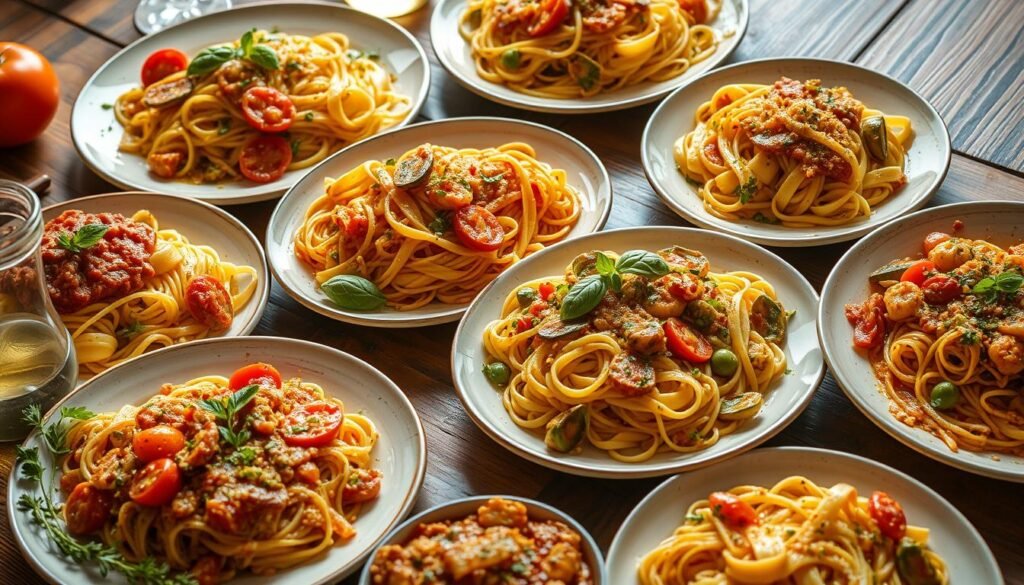
Exploring Central Italian Variations
Central Italy’s diverse culinary scene is seen in its pasta dishes. From Tuscany’s pici to Rome’s cacio e pepe, each region has its own twist. This mix of old and new creates a rich world of flavours, loved by pasta fans everywhere.
Regional Differences in Pasta
In Central Italy, pasta traditions vary by region. Tuscany’s pici noodles, thick and hand-rolled, are a sign of the region’s rustic beauty. They’re often served with rich meat sauces.
Rome is famous for cacio e pepe, a simple yet tasty dish. It shows Rome’s skill in combining pasta and cheese. In Abruzzo, the strascinati noodles, with their unique texture, pair well with fresh seafood.
Fusion Dishes to Try
Chefs in Central Italy love to mix old and new in their cooking. A spicy arrabbiata sauce with nduja sausage is a bold twist on a classic Roman dish. Adding seasonal produce, like cime di rapa in orecchiette, shows how traditional recipes can evolve.
These variations and fusion dishes show the depth and variety of Central Italy’s pasta culture. They invite those who love to try new things to explore the rich flavours of this culinary region.
| Pasta Shape | Regional Origin | Signature Dish |
|---|---|---|
| Pici | Tuscany | Pici all’Aglione |
| Cacio e Pepe | Rome | Cacio e Pepe |
| Strascinati | Abruzzo | Strascinati con Pesce |
Tips for Cooking Pasta to Perfection
Mastering pasta cooking is key in Central Italian cuisine. Timing is crucial for the perfect al dente texture. Whether it’s fresh or dried pasta, knowing cooking times is vital.
Timing and Texture
Fresh pasta cooks faster than dried. For instance, fresh pappardelle cooks in 2-3 minutes. Orecchiette takes 3-4 minutes, and fresh ravioli needs 5-6 minutes. Dried pasta should be undercooked by one minute to get the right firmness.
Salt Usage
Seasoning the pasta water with salt is important. Use 1.5 tablespoons of plain salt for 400 grams of pasta. This boosts the pasta’s flavour, making it taste great with the sauce. Add salt to the water before it boils.
By learning these timing and seasoning tips, you’ll make fresh pasta recipes and artisanal pasta making that truly capture Central Italy’s flavours.

| Pasta Type | Cooking Time |
|---|---|
| Fresh Pappardelle | 2-3 minutes |
| Fresh Orecchiette | 3-4 minutes |
| Fresh Ravioli | 5-6 minutes |
| Dried Pasta | 1 minute less than package instructions |
“The secret to cooking pasta is in the timing and seasoning. Get those right, and you’ll have a dish that truly shines.”
– Emilie Pullar, Course: Shapes + Guides, Cuisine: Italian
Discovering Side Dishes for Pasta Meals
Italian culinary traditions are rich and authentic. Side dishes play a big role in making a meal balanced and enjoyable. From fresh salads to inviting antipasti, these elements add quality and flavour to the meal.
Fresh Salads
A light salad is perfect with pasta’s heartiness. An insalata mista, or mixed green salad, is a classic choice. It has fresh lettuces, peppery arugula, and crisp veggies, all dressed in a simple vinaigrette.
For a burst of colour and texture, try a caprese salad. It has juicy tomatoes, creamy mozzarella, and fragrant basil. It’s a great match for many pasta dishes.
Antipasti Ideas
Italians are experts at making delicious antipasti, or appetizers. The classic bruschetta is a favourite. It has crunchy toasted bread, ripe tomatoes, and aromatic garlic.
Marinated vegetables and cured meats are also popular. These small bites get you ready for the main pasta dishes.
| Side Dish | Ingredients | Preparation |
|---|---|---|
| Arugula Salad | 150g (5 oz) arugula leaves, 15g (0.5 oz) shaved Grana Padano or Parmesan cheese | Toss the arugula leaves with a simple vinaigrette dressing, then top with shaved Grana Padano or Parmesan cheese. |
| Garden Salad | 1 cup cherry tomatoes, 1 cucumber, 1/2 red onion, 1/2 cup olives, 4 cups mixed greens (lettuce, arugula, spinach) | Chop the vegetables and toss them with the mixed greens in a large salad bowl. Dress with a light vinaigrette. |
| Chunky Chips | 4-5 large potatoes, 4-6 cups rapeseed or vegetable oil | Cut the potatoes into thick, chunky fries. Heat the oil in a deep fryer or large pot and fry the potato chunks until golden brown and crispy. |
These side dishes, rooted in Italian culinary traditions, perfectly complement the rich and authentic pasta dishes. They create a harmonious and satisfying dining experience.

Celebrating Pasta in Italian Culture
Pasta is a big deal in Italian culture. It’s a key part of the country’s traditions. From big festivals in Central Italy to family dinners, pasta is at the heart of Italian cuisine.
Festivals and Events in Central Italy
In Central Italy, pasta festivals are a big deal. These events show off the art of making pasta. You’ll see towns and cities with demos, tastings, and competitions.
These gatherings are for locals and visitors. They celebrate the skill and tradition behind Italian pasta.
The Role of Pasta in Family Gatherings
Family is key in Italian culture, and pasta is central to family meals. For generations, families have shared pasta recipes. Each family adds their own twist to classic dishes.
Whether it’s a Sunday dinner or a big celebration, pasta is the star. A table full of homemade pasta, sauces, and sides shows the importance of pasta in Italian culinary traditions.
“In Italy, we don’t eat to live, we live to eat.”
This saying shows how much food, and pasta, means to Italians. Pasta is more than just food. It’s a way to connect, keep traditions alive, and enjoy life.
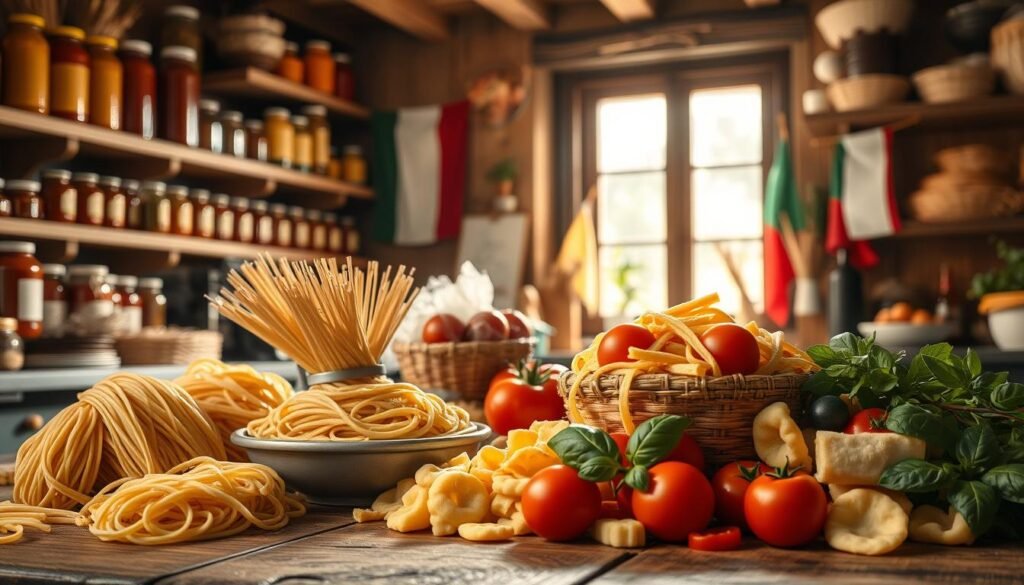
Exploring traditional Central Italian pasta reveals a world of traditions and celebrations. It shows how pasta shapes the Italian culinary landscape.
Adapting Traditional Recipes for Modern Dietary Needs
Dietary preferences are changing, and so are our pasta recipes. Luckily, we now have many options to suit different needs. This means more people can enjoy the delicious tastes and textures of classic pasta dishes.
Gluten-Free Pasta Options
For those who can’t eat gluten, there’s good news. High-quality gluten-free pasta is now available. Made from rice, corn, or chickpeas, it looks and feels like traditional pasta. It also keeps the true taste of the original dishes.
Vegan Adaptations
Vegans can also enjoy Central Italian pasta. Creative swaps, like using nutritional yeast for cheese, make vegan versions possible. These changes keep the dish’s flavour while meeting vegan dietary needs.
Exploring traditional Central Italian pasta ideas and fresh pasta recipes is easier than ever. Whether you’re gluten-free, vegan, or just want more plant-based meals, Central Italy’s culinary world welcomes you.

Where to Find Authentic Central Italian Pasta
Exploring authentic Central Italian pasta is more than just cooking at home. To dive deep into this rich cuisine, you must find the right places. Look for local Italian restaurants and specialty stores for genuine pasta dishes.
Local Italian Restaurants
Local Italian restaurants are great for finding real Central Italian pasta. They use top-notch ingredients, often from Italy itself. Here, you can enjoy dishes like cacio e pepe and pasta alla gricia, just as they are made in Central Italy.
Farmers’ Markets and Specialty Stores
Don’t just stick to restaurants. Farmers’ markets and specialty stores are full of authentic pasta. Artisanal producers here make pasta, sauces, and more with love. By shopping here, you support local talent and enjoy authentic pasta dishes and regional Italian cuisine.
“Immerse yourself in the rich tapestry of Central Italian culinary traditions, where every bite tells a story of the region’s unique heritage.”
Whether you choose a local Italian restaurant or a farmers’ market, you’re in for a treat. Enjoy the unique tastes and stories behind each dish. Let your taste buds lead you on a culinary journey through Italy.
Conclusion: Embracing Central Italian Pasta at Home
Exploring Central Italy’s rich culinary heritage is exciting. Now, it’s time to bring these authentic flavours into your kitchen. Making your own pasta and trying traditional recipes are key.
Making Your Own Pasta
Hand-making pasta is incredibly rewarding. You’ll learn to appreciate the art of making classic shapes like fettuccine and pici. This hands-on approach lets you experiment with different flours and cooking methods.
Encouragement to Explore Recipes
Exploring Central Italian pasta recipes is a journey. You’ll discover the variety of ragus, tomato sauces, and creamy dishes. Using seasonal ingredients and pairing pasta with wine will make your meals even better.
